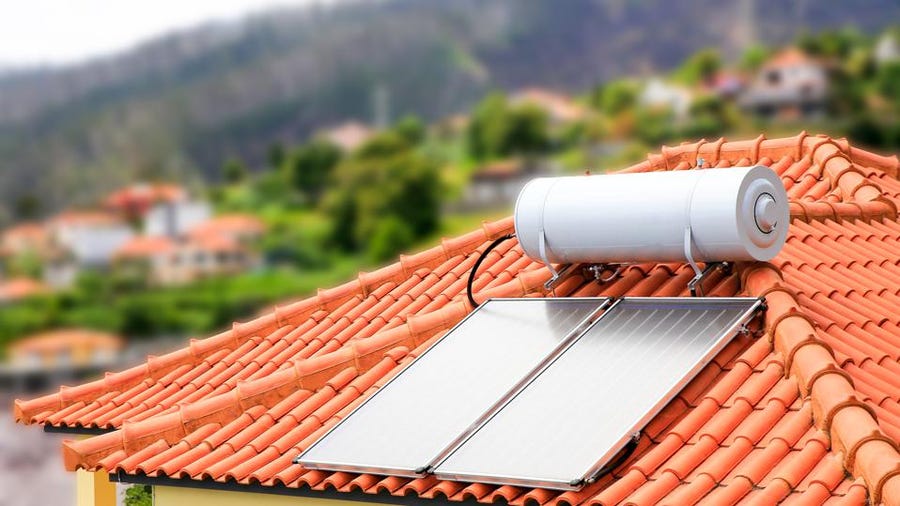
Solar Water Heater
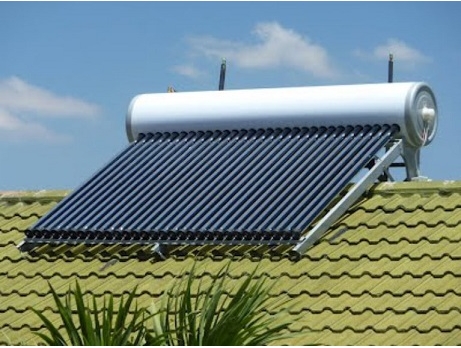
A solar water heater is a type of technology that harnesses the power of the sun to heat water for domestic, industrial, or commercial use. The system typically consists of a solar collector, storage tank, and a circulation system.
The solar collector is responsible for capturing the energy from the sun and converting it into thermal energy. This is usually done using a flat-plate or evacuated-tube collector, which are designed to absorb sunlight and convert it into heat. The collector is usually mounted on the roof of a building or on a ground-mounted support structure.
Once the collector has heated the water, it is stored in an insulated tank. The storage tank is usually positioned near the solar collector to minimize heat loss during the transfer process. Some systems also use a backup heating source, such as a gas or electric heater, to ensure that hot water is always available, even on cloudy days or during periods of high demand.
A circulation system is used to transport the heated water from the collector to the storage tank and then to the point of use. This is usually done using a pump or a gravity-fed system. The circulation system also helps to ensure that the water is evenly heated and distributed throughout the building.
Solar water heaters can be used in a variety of settings, including homes, hotels, hospitals, and industrial facilities. They offer a number of benefits, including reduced energy costs, reduced carbon emissions, and increased energy independence. In many areas, governments also offer financial incentives to encourage the installation of solar water heaters, making them an attractive option for many consumers.
Solar Collection
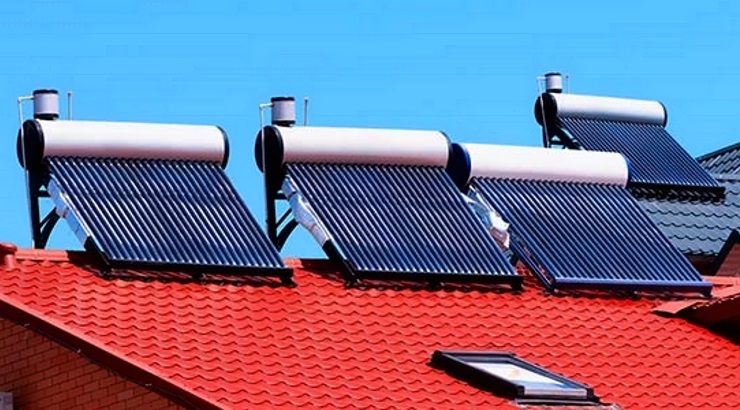
A solar collector is the most critical component of a solar water heating system, responsible for capturing the energy from the sun and converting it into thermal energy to heat water. There are different types of solar collectors available, but they all work on the same basic principle: to absorb sunlight and convert it into heat.
One of the most common types of solar collectors is the flat-plate collector, which is made up of an insulated metal box with a flat plate of absorber material inside. The absorber material is typically made of copper or aluminum and is coated with a black coating that absorbs sunlight and converts it into heat. A layer of insulation on the bottom and sides of the collector helps to reduce heat loss.
Another type of solar collector is the evacuated-tube collector. This design consists of a series of glass tubes with a vacuum inside. Each tube contains a copper or aluminum absorber, which is coated with a black coating to absorb sunlight and convert it into heat. The vacuum inside the tube acts as an insulator, reducing heat loss and improving efficiency.
A third type of solar collector is the concentrating collector, which uses mirrors or lenses to focus sunlight onto a small area, creating a high temperature. This concentrated heat can be used to generate electricity or to heat water directly.
The type of solar collector used depends on factors such as the climate, the availability of sunlight, and the application of the solar water heating system. Flat-plate collectors are suitable for most climates, while evacuated-tube collectors are more efficient in colder climates. Concentrating collectors are typically used in large-scale solar power plants rather than in residential or commercial water heating systems.
In conclusion, solar collectors are an essential component of solar water heating systems, responsible for capturing and converting the energy from the sun into thermal energy. The type of collector used will depend on a range of factors, and it’s essential to choose the appropriate type to ensure efficient operation of the system.
Types of Solar Water Heater
There are several types of Solar Water Heater, but following are some most common ones….
Table all in one solar water heater:
This is a compact, portable solar water heater that combines the solar collector and water tank into a single unit. It is designed to be placed on a flat surface, such as a table, and can be easily moved to different locations. Table all in one solar water heaters are typically used for small-scale applications, such as camping or outdoor events.
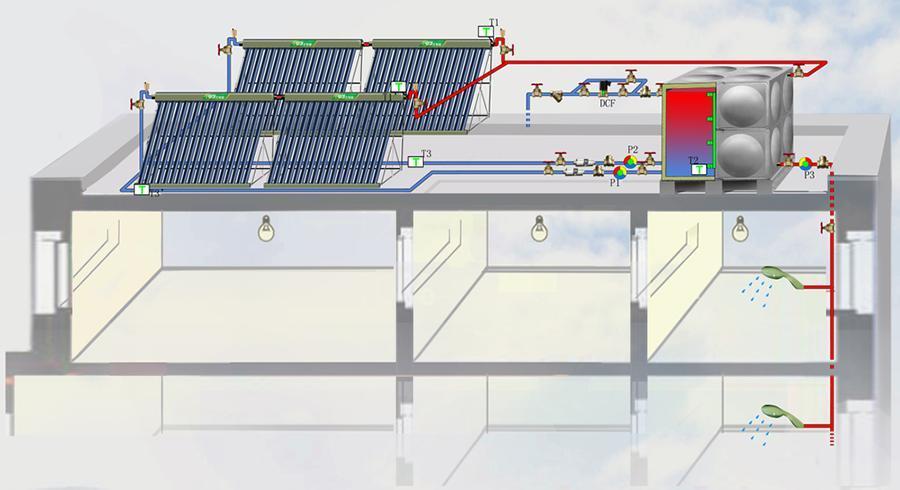

HM210 Solar Water Heater:
The HM210 is a type of solar water heater that uses an evacuated tube collector to absorb solar radiation and heat water. It has a storage tank capacity of 210 liters and is designed for residential or commercial use. The HM210 solar water heater is known for its high efficiency and durability.
HM180 Solar Water Heater:
The HM180 is another type of solar water heater from the same manufacturer that uses an evacuated tube collector. It has a storage tank capacity of 180 liters and is designed for residential use. The HM180 solar water heater is also known for its high efficiency and reliability.

Storage Tank
Storage tanks are another crucial component of solar water heating systems. They store hot water generated by the solar collector for use when needed. There are two types of storage tanks commonly used in solar water heating systems: passive and active.
A passive storage tank relies on natural convection to circulate the water. This means that the storage tank is located above the collector and uses gravity to move hot water from the collector to the tank. Passive systems are generally less expensive and simpler to install, but they may not be as efficient as active systems.
An active storage tank uses a pump to circulate the water. The pump moves the hot water from the collector to the storage tank and back again when needed. Active systems can be more efficient than passive systems, but they require electricity to operate the pump, which can increase the cost of the system.
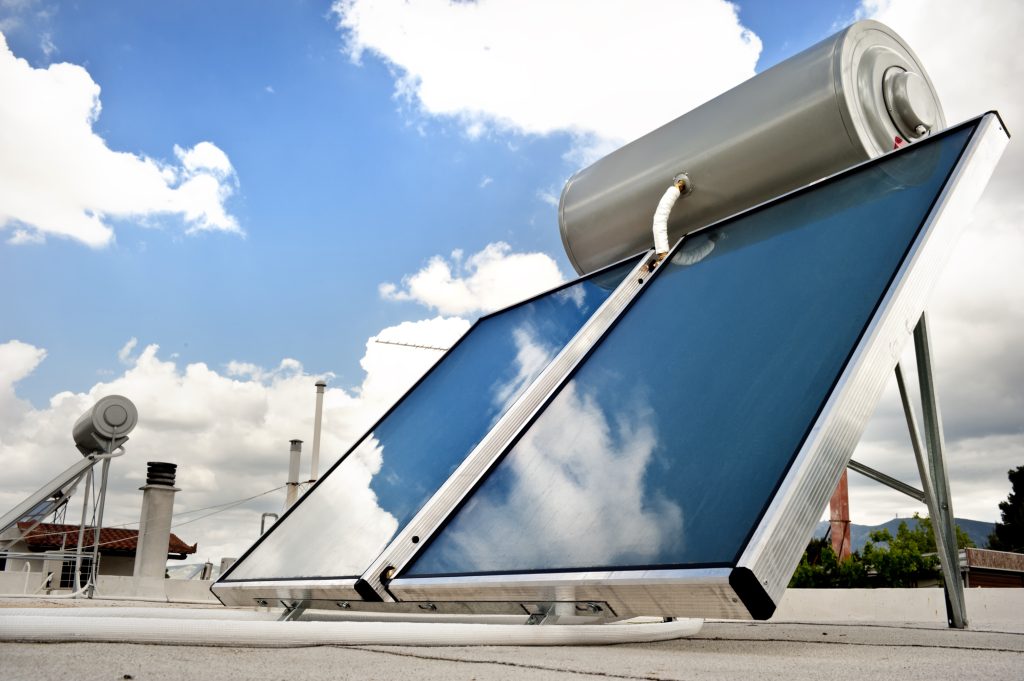
The size of the storage tank needed for a solar water heating system depends on the amount of hot water needed and the climate in which the system is installed. In colder climates, a larger tank may be necessary to ensure that there is enough hot water available during periods of low sunlight.
The storage tank is typically insulated to minimize heat loss and keep the water hot. Different types of insulation materials can be used, including fiberglass, foam, and rubber. The insulation material used will depend on the specific requirements of the system.
In conclusion, storage tanks are a crucial component of solar water heating systems. They store hot water generated by the solar collector for use when needed. There are two types of storage tanks commonly used in solar water heating systems: passive and active. The size and insulation of the storage tank will depend on the specific requirements of the system.
Circulation System
The circulation system in a solar water heating system is responsible for moving the water from the storage tank to the point of use. The system is made up of a pump, pipes, and valves that work together to circulate the water.
The pump is used to move the water from the storage tank to the point of use. The pump is typically controlled by a thermostat or a controller that monitors the temperature of the water in the storage tank and turns the pump on and off as needed.
The pipes used in the circulation system are usually made of copper, PVC, or other materials that are compatible with hot water. The pipes are insulated to reduce heat loss and ensure that the hot water reaches the point of use at the desired temperature.
Valves are used to control the flow of water in the system. There are different types of valves, including manual valves that are operated by hand and automatic valves that are controlled by a thermostat or a controller.
The circulation system can be designed in different ways depending on the specific requirements of the system. One common design is the open-loop system, which circulates the water directly from the storage tank to the point of use. Another design is the closed-loop system, which uses a heat exchanger to transfer the heat from the solar collector to the storage tank.
The circulation system is an essential component of a solar water heating system, as it ensures that hot water is available when needed. It’s important to design the system carefully to ensure that it is efficient and reliable.
In conclusion, the circulation system in a solar water heating system is responsible for moving the water from the storage tank to the point of use. The system is made up of a pump, pipes, and valves that work together to circulate the water. The design of the circulation system will depend on the specific requirements of the system.
Backup Heating
Backup heating is an important component of solar water heating systems, as it ensures that hot water is available even when there is not enough sunlight to heat the water. Backup heating systems can be electric or gas-powered, and they are typically used as a secondary source of heat when solar energy is not sufficient.
Electric backup heating systems are the most common type of backup heating used in solar water heating systems. They typically consist of a heating element that is installed in the storage tank. When the water in the storage tank is not hot enough, the heating element is activated, and electricity is used to heat the water. Electric backup heating systems are easy to install and operate, but they can be expensive to operate if used frequently.

Gas backup heating systems are another option for solar water heating systems. They typically use a gas burner that is connected to the storage tank. When the water in the storage tank is not hot enough, the gas burner is activated, and the gas is used to heat the water. Gas backup heating systems are more expensive to install than electric systems, but they can be more cost-effective to operate in areas where gas is relatively inexpensive.
The backup heating system is typically controlled by a thermostat or a controller that monitors the temperature of the water in the storage tank. When the temperature drops below a certain level, the backup heating system is activated, and the water is heated.
In conclusion, backup heating is an essential component of solar water heating systems. It ensures that hot water is available even when there is not enough sunlight to heat the water. Backup heating systems can be electric or gas-powered and are typically controlled by a thermostat or a controller that monitors the temperature of the water in the storage tank. The type of backup heating used will depend on the specific requirements of the system and the cost of energy in the area.
Applications
Solar water heating systems have a variety of applications in residential, commercial, and industrial settings. Here are some examples:

Government Incentives
Many governments around the world offer incentives and rebates for the installation of solar water heating systems. These incentives are designed to promote the use of renewable energy and reduce greenhouse gas emissions. Here are some examples of government incentives for solar water heating systems:
Tax credits: Some governments offer tax credits to homeowners and businesses that install solar water heating systems. These tax credits can reduce the upfront cost of the system and provide long-term savings on energy bills.
Grants: Some governments offer grants to homeowners and businesses that install solar water heating systems. These grants can cover a portion of the installation cost and help to make the system more affordable.
Feed-in tariffs: Some governments offer feed-in tariffs to homeowners and businesses that generate their own electricity from solar water heating systems. These feed-in tariffs provide a financial incentive for the installation of the system and can help to offset the cost of electricity.
Rebates: Some governments offer rebates to homeowners and businesses that install solar water heating systems. These rebates can provide a direct financial incentive for the installation of the system and help to make it more affordable.
Net metering: Some governments offer net metering programs that allow homeowners and businesses to sell excess electricity generated by their solar water heating systems back to the grid. This can provide a financial incentive for the installation of the system and help to offset the cost of electricity.
In conclusion, many governments offer incentives and rebates for the installation of solar water heating systems. These incentives are designed to promote the use of renewable energy and reduce greenhouse gas emissions. The specific incentives available will depend on the government and the region, but they can provide a significant financial benefit for those who choose to install solar water heating systems.
Conclusion
In conclusion, solar water heating systems are an environmentally friendly and cost-effective alternative to traditional water heating systems that rely on fossil fuels. These systems utilize the energy from the sun to heat water, which can then be used for a variety of purposes, including bathing, cleaning, and heating. They are particularly useful in areas with abundant sunlight and limited access to reliable energy sources.
Solar water heating systems consist of a solar collector, storage tank, circulation system, and backup heating system, each of which plays a vital role in the operation of the system. Governments around the world offer incentives and rebates for the installation of solar water heating systems, which can help to offset the cost of installation and make the systems more affordable.
Overall, solar water heating systems offer a range of benefits, including energy savings, environmental sustainability, and reduced reliance on fossil fuels. As the world looks for ways to reduce its carbon footprint and transition to renewable energy sources, solar water heating systems are a viable option that can make a significant impact.
